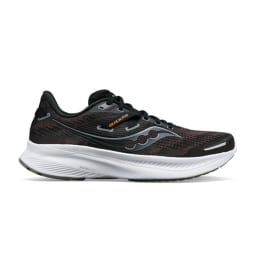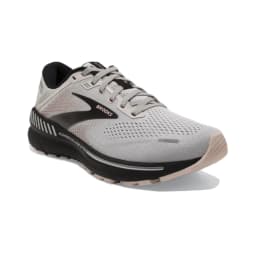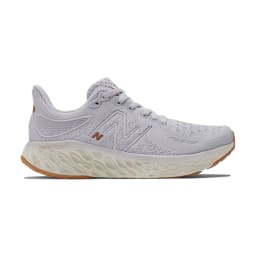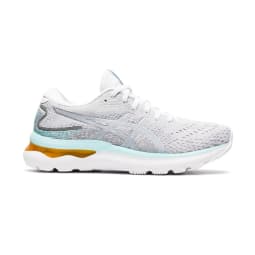Advertisement
The 5 Best Stability Running Shoes Of 2023 + Podiatrist Recommendations


- Best for long runs: Saucony Guide 16
- Best for recovery runs: Hoka Arahi
- Best for the treadmill: Brooks Adrenaline GTS 22
- Best for road running: ASICS GT 2000 11
- Best or women: New Balance Fresh Foam 860v13
Each activity, terrain, and (most importantly) foot is unique—and no shoe is one size fits all. The best stability running shoes are designed specifically to offer optimal support and stability for those with flat feet and gait issues, particularly overpronation.
If you do overpronate or have flat feet and you're not wearing stability running shoes, you're more likely to experience pain, injury, and discomfort from running.
Of course, there's more to shoe shopping than meets the eye; podiatrists have a few key parameters to keep in mind when shopping for the best stability running shoes.
What are stability running shoes?
"Stability shoes are designed for runners who have flat feet," says holistic podiatrist Hillary Brenner. "A side dish that comes with flat feet is overpronation (when the foot rolls inward). A stability running shoe is designed to correct overpronation.”
Put simply, by having extra cushion in the arch area, the best stability running shoe helps keep the runner’s feet in a neutral position.
Overpronation is a common gait issue in which the foot rolls inward excessively during the running or walking stride. It can lead to issues such as shin splints, knee pain, and IT band syndrome.
Not sure if you have flat feet or overpronation? The best way to find out is through a gait analysis, which you can get from an expert at a running store or by a podiatrist.
Who should wear stability running shoes?
Overpronators
If you've been told by a podiatrist or running specialist that you have overpronation, stability running shoes can help provide the necessary support to correct this issue. It's best to consult with a podiatrist or running expert, as severe overpronators might benefit more from motion control shoes, which offer even more support.
Flat feet
People with flat arches are more likely to overpronate, making stability shoes a good choice for them.
History of injuries
If you've experienced injuries or pain related to overpronation, such as shin splints, plantar fasciitis, or knee pain, stability shoes may help reduce the risk of further injury.
Distance runners
The added support and stability is beneficial for maintaining proper form and comfort during extended runs.
Beginners
New runners who are unsure of their gait pattern can start with stability shoes as they provide a good balance of cushioning and support. You can also consult a specialist for a gait analysis to determine the most suitable type of shoe.
High arches
Chiropractor Sarah Sponaugle says runners with high arches need to be aware if they’re over pronating. “When an individual has high arches, they need arch support but not necessarily a stability shoe. I have seen as high arches collapse and the individuals start to overpronate. At that point, they would be a candidate for a stability shoe.”
What to look for in stability running shoes
Experts agree that the best stability running shoes offer the following features:
Arch support
Stability running shoes typically have a medial post, which is a firmer material in the midsole, to support the arch of the foot and limit excessive pronation.
Cushion
Stability running shoes provide a balance between cushioning and support, making them suitable for runners with mild to moderate overpronation. “By having extra cushion in the arch area, it will help keep the runner’s feet in a neutral position,” says Brenner.
Appropriate outsole
Sponaugle says, “When looking for a good stability shoe, it is essential to consider the terrain that one will be running on when wearing the shoe.” Be sure to consider whether you’ll be running on the road or the treadmill and look for a shoe with an outsole designed specifically for that terrain.
Structured midsole
The midsole often includes dual-density foam or other technologies that enhance stability and help control the inward rolling motion of the foot.
Reinforced heel counter
Stability running shoes have a reinforced heel counter to provide additional support and stability to the heel and ankle.
Our picks for the best stability running shoes of 2023:
Best for long runs: Saucony Guide 16

Pros:
- Flexible
- Contours to your foot
- APMA certified
Cons:
- Might run small
Materials:
VeganRecycled materialsSizes available:
5-12Half sizes availableWide sizes availableColorways:
7Drop:
8 mmWeight:
9.5 ozReturn policy:
30 daysThis APMA certified pick is the brand's mid-level stability shoe, meaning it offers a moderate stack height and just enough medial stability to reduce the effects of overpronation.
Brenner recommends this stability running shoe for patients looking for a moderate level of support. It has an appropriate amount of cushion, thanks to a thick stack of the brand's signature EVA-based foams.
A carved-out footbed allows your foot to sit inside the cushioning rather than on top of it for even more support.
Pros:
- Plenty of forefoot support
- Combats overpronation
- Lightweight
Cons:
- Heel is slightly narrow for some
Materials:
FoamRubberSizes available:
5-12Colorways:
7Drop:
5 mmWeight:
7.6 ozReturn policy:
30 daysOne of the best treadmill running shoes, particularly for flat feet, Hoka’s Arahi model is quite light for a stability shoe. It has a stabilizing frame that pairs maximal cushioning and minimal weight.
The shoe's active foot frame cradles the foot, ensuring both stability and comfort. The incorporation of a mesh lining, compression-molded foam insole, and an integrated meta-rocker mechanism contributes to a smoother and more comfortable wearing experience while bolstering support for the forefoot.
Advertisement
Best for the treadmill: Brooks Adrenaline GTS 22

Pros:
- Orthotic-friendly
- APMA seal of acceptance
- Recycled materials
Cons:
- A bit heavy
- Shorter laces
Materials:
FoamRubberRecycled water bottlesSizes available:
5-13Colorways:
28Drop:
12 mmWeight:
10.2 ozReturn policy:
90 daysA top recommended stability running shoe from Brenner, this APMA certified pick works well for treadmill or outdoor runs. In fact, we've also featured it as the best stability running shoe in our roundups of the best treadmill running shoes and the best shoes for knee pain.
The brand’s GuideRails technology keeps the foot in alignment, offering a solid balance of support and cushion.
What's more, Brooks makes a respectable effort toward sustainability when compared with others in the space. This shoe uses recycled materials, such as plastic water bottles, and the company has plans to achieve net zero carbon emissions by 2040.
Pros:
- Podiatrist approved
- Adjusts to your foot shape
- Lightweight
Cons:
- Some say they're not very durable
Materials:
Partially recycled materialsEngineered meshBio-based cellulose nanofiberSizes available:
5-13Colorways:
18Drop:
8 mmWeight:
8.2 ozReturn policy:
30 daysBrenner says these stability running shoes have the right amount of cushion in all the right places for overpronators.
The brand use patented technology cushioning which provides medial support and midfoot integrity with lightweight cushioning and a responsive rebound. Next, the rearfoot gel technology improves impact absorption and creates a softer feeling at footstrike.
Brenner confirms that these road running shoes for stability have moderate cushioning. So if you are going for longer runs, to consider ones with moderate high support.
Advertisement
Best or women: New Balance Fresh Foam 860v13

Pros:
- Four widths available
- Neutral colors for versatile wear
Cons:
- Some say the soles wear quickly
Materials:
Bio-based and/or recycled materialsSizes available:
5-13Half sizes availableColorways:
15Drop:
Not specifiedWeight:
8.6 ozReturn policy:
45 daysBrenner recommends this shoe to those needing a stability shoe that’s moderately cushioned. It's the latest entry in the Fresh Foam series, delivering the pinnacle cushioning experience with a supportive medial post to provide essential stability.
Designed for reliability over the long haul and sustained comfort over all distances, the 860 is great for all terrains and running distances.
And, since we’re always on the hunt for a sustainable running shoe, we appreciate the brand's efforts. This shoe’s upper is made of 50% or more recycled content, and at least one midsole/outsole material contains a minimum of 3% bio-based or 5% recycled content.
How we picked:
Podiatrist recommendations
The shoes on our list have either been chosen directly by our experts, or meet their specific criteria. We also sought out shoes with the APMA Seal of Acceptance.
Features
Per our experts' advice, proper arch support, cushion, a deep heel cup, and a wide base were all considered when selecting the best stability running shoes.
Price
Stability running shoes can get expensive (especially when you’re replacing them every 300 miles), so we included a range of products to fit various budgets.
Sustainability
There's a lot of work to be done to make the sneaker industry more eco-friendly, but some brands are making a better effort than others. We looked out for those that use sustainable materials and noted this in the product description.
Comparing the best stability running shoes
| Product | Price | Sizes available | Colorways | Return policy | Drop | Weight |
|---|---|---|---|---|---|---|
| Hoka Arahi | $140 | 5-12 | 7 | 30 days | 5 mm | 7.6 oz |
| ASICS GT 2000 11 | $159 | 5-13 | 18 | 30 days | 8 mm | 8.2 oz |
| New Balance Fresh Foam 860v13 | $140 | 5-13 | 15 | 45 days | 5 mm | 8.6 oz |
| Brooks Adrenaline GTS | $109 | 5-13 | 28 | 90 days | 12 mm | 10.2 oz |
| Saucony Guide 16 | $140 | 5-12 | 7 | 30 days | 8 mm | 9.5 oz |
How to choose stability running shoes
It’s essential to understand your foot type and gait to determine whether you should wear stability running shoes.
First, fnd out if you're flat-footed (overpronator) or have high (underpronator/supinator) or neutral arches by visiting a podiatrist or specialty running store for a gait analysis.
When shopping for a stability running shoe, Brenner says it’s important to look for the following:
- A firm, high arch to limit excessive pronation
- Cushion in the arch to provide a balance between comfort and support
- A deep heel cup to help align your foot and ankle an keep them in a straight position
- A wide-base platform underneath which will help prevent in ward rolling (overpronation)
She recommends going shoe shopping towards the end of the day, as that’s when your feet are true to size due to swelling, and having your foot measured while standing, to capture the appropriate width and length of your foot.
How running impacts our health and longevity
If you’re interested in tips on how to live longer, you’ll love to know that staying active by running has wonderful benefits to our physical health, mental health, and longevity.
Running is a form of Zone 2 cardio, which comes with longevity benefits1 that lessen your risk for cardiovascular disease and Type 2 Diabetes.
If you’re amongst the runners who can benefit from stability shoes, investing in the right pair will help you have a smaller risk of injury and keep you on the road (pun intended) to a longer life.
FAQ:
What is the difference between stability and support running shoes?
Stability running shoes are designed for runners who overpronate, with a focus on controlling the inward rolling of the foot. Support running shoes provide a general level of support and comfort without targeting overpronation specifically.
Can neutral feet wear stability shoes?
Runners with neutral feet should opt for neutral running shoes for the most comfortable and efficient running experience. Podiatrist Hillary Brenner recommends visiting a running store or podiatrist to have a gait analysis performed by a specialist.
Can stability shoes cause knee pain?
Stability shoes aim to address knee pain or shin splints caused by overpronation when running. That said, if you aren't sure whether your shoes are right for your specific food and unique needs, it's best check with a podiatrist.
Do stability shoes have arch support?
Yes, per podiatrist Hillary Brenner, arch support is a crucial element of stability running shoes.
The takeaway
When choosing the best stability running shoes, our experts recommend considering factors such as arch support, cushioning, a wide base, and a deep heel. Your shoes have a huge impact on your comfort and performance even when you're not running, so make sure you're lacing up with the best footwear for flat feet all day long.

